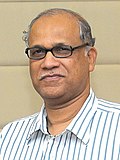A request that this article title be changed to Chief Minister of Goa is under discussion . Please do not move this article until the discussion is closed. |
| Chief Minister of Goa | |
|---|---|
 | |
| Style | The Honourable (Formal) Mr./Mrs. Chief Minister (Informal) |
| Status | Head of Government |
| Abbreviation | CM |
| Member of | Goa Legislative Assembly& Goa Council of Ministers |
| Reports to | Governor of Goa |
| Appointer | Governor of Goa |
| Term length | At the confidence of the assembly Chief minister's term is for five years and is subject to no term limits. [1] |
| Inaugural holder | Pratapsingh Rane as Chief Minister of Goa state Dayanand Bandodkar as Chief Minister of the Union Territory of Goa, Daman and Diu |
| Formation | 20 December 1963 |
| Deputy | Deputy Chief Minister of Goa |
The chief minister of Goa is chief executive of the Indian state of Goa. As per the Constitution of India, the governor is a state's de jure head, but de facto executive authority rests with the chief minister. Following elections to the Goa Legislative Assembly, the state's governor usually invites the party (or coalition) with a majority of seats to form the government. The governor appoints the chief minister, whose council of ministers are collectively responsible to the assembly. Given that he has the confidence of the assembly, the chief minister's term is for five years and is subject to no term limits. [1]
Contents
- Chief ministers of Goa, Daman and Diu
- Chief ministers of Goa
- Statistics
- Timeline
- See also
- Notes
- External links
After the annexation of Goa, the former Portuguese colony became part of the Goa, Daman and Diu union territory. In 1987 Goa achieved full statehood, while Daman and Diu became a separate union territory. Since 1963, thirteen people have served as the chief minister of Goa, Daman and Diu union territory and of Goa state. The first was Dayanand Bandodkar of the Maharashtrawadi Gomantak Party, who was succeeded by his daughter Shashikala Kakodkar, Goa's only woman chief minister. Pratapsingh Rane of the Indian National Congress, during whose reign Goa had achieved statehood, is the longest-serving officeholder also holds the record for the longest continuous tenure, with over 15 years across four discontinuous stints.
The current incumbent is Pramod Sawant of the Bharatiya Janata Party, who was sworn in on 19 March 2019 after the death of Manohar Parrikar on 17 March 2019.












